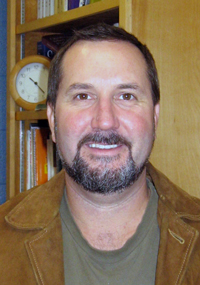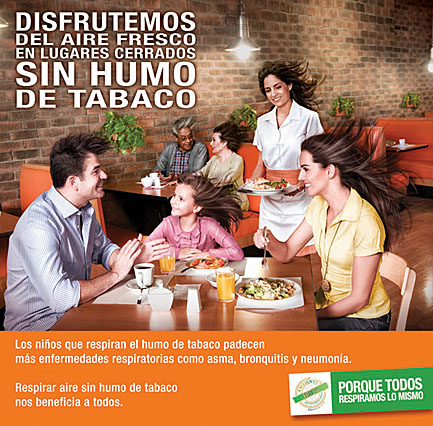Mexico has been fertile ground for Thrasher's smoking research
May 25, 2009

Dr. Jim Thrasher
While concerns about the Swine Flu spread, most Americans are passing on travel to Mexico these days.
But USC researcher Dr. Jim Thrasher has a date to celebrate World No Tobacco Day in the Mexican capital, where he is concerned with a different public health crisis – the growing epidemic of tobacco use in low- and middle-income countries.
Thrasher has been conducting research in Mexico for many years and is a key player in diverse efforts to promote and evaluate Mexico's historic efforts to prevent the social and personal harms of tobacco use.
The Arnold School of Public Health associate professor is also an adjunct researcher and visiting professor at the Mexican National Institute of Public Health, as well as a member of a worldwide network of tobacco researchers and activists who promote the World Health Organization’s Framework Convention on Tobacco Control (WHO-FCTC).
Each May 31, the WHO celebrates World No Tobacco Day. Established in 1987, this annual observance calls attention to the widespread prevalence of tobacco use and to its negative health effects.
This May 31 will find Thrasher at the Mexican National Academy of Medicine, where he will join Mexican Minister of Health Dr. José Ángel Córdova Villalobos in a panel and press conference on upcoming federal tobacco control legislation.
"World No Tobacco Day is a big media event in most parts of the world, and much of my work involves generating media interest in tobacco control. The press conference with Minister Córdova Villalobos will be critical for getting the media focused on the key arguments to advance federal tobacco control legislation in Mexico.
"However, other efforts in the media are also necessary to successfully combat an enterprise as powerful and rich as the tobacco industry. My intervention research spans the spectrum from paid mass media campaigns to getting new sectors of civil society involved in and transmitting effective advocacy messages in favor of tobacco control,” Thrasher said.

Last year, Thrasher worked with the Federal and Mexico City Ministries of Health to develop and evaluate a social marketing campaign titled Porque todos respiramos lo mismo ("Because we all breathe the same air") that ran in the Mexico City market last fall.
This radio, television, billboard and newspaper campaign aimed to promote acceptance of and support for comprehensive smoke-free legislation in Mexico City.
“In the case of Mexico City, the smoke-free law was passed very quickly, before we had the funding to get our campaign off the ground. Successful campaigns of this type usually begin before the law is implemented, emphasizing the dangers of secondhand smoke, and after the law is passed, they emphasize the positive benefits of the law. Because our campaign was launched after the law came into effect, we emphasized the positive benefits, while providing reminders of why the law was important,” Thrasher said.
One television ad that is available on YouTube reminds people of the toxic chemicals in cigarette smoke and features a young couple buffeted by a burst of fresh air once they enter a restaurant.
Thrasher, who smoked for 20 years, said his research and advocacy are driven by personal interest and his distain for “the reprehensive behavior of the tobacco industry as it expands its market without consideration of the human lives that its expansion cuts short. Most of my work involves a focus on mass media and policy because combating the tobacco industry demands more than just education in schools,” he said.
Thrasher has been researching tobacco use and prevention for ten years, beginning with his work on the US “truth” campaign, which aimed to prevent youth smoking by focusing on the deceitful practices of the tobacco industry.
For the last eight years, his projects in Mexico include research on the uptake of smoking among Mexican youth, analysis of print media stories on tobacco, analysis of smoking portrayals in popular movies, the influence of tobacco in cinema on youth smoking, the impact of pictorial health warning labels on cigarette packs, and his recent work to evaluate diverse taxes, and smoke-free policies.
Thrasher has found Mexico fertile ground for research because it is one of some 164 countries representing about 89 percent of the world’s population that have signed the 2005 WHO Framework Convention on Tobacco Control.
The international treaty obligates signatory nations to implement anti-tobacco policies in the face of growing influence from the tobacco industry.
The United States has not signed the treaty, but Thrasher says he’s encouraged by President Obama’s expressed commitment to the FCTC as well as Congressional efforts to put regulation of tobacco products under the Food and Drug Administration. That law, which has passed the House, currently is under consideration by the Senate.
Thrasher says the FDA is already considering stronger health warnings on cigarette packages. In the current proposal, the text of the warnings would vary, but all would be in large type and occupy some 30% of the front and back of the package – a much more prominent display than the 50% of the side of the pack that has been in force for the last 25 years.
In many other countries, the warnings are accompanied by graphic – some say gruesome – images of the impact of smoking on the body. With support from the Robert Wood Johnson Foundation, Thrasher is part of a team that is testing the added impact of such pictorial warnings among adult smokers in Columbia, SC, San Diego, CA, Buffalo, NY and a rural area in Pennsylvania.
He is also a member of a team that has received funding from the National Institutes of Health to assess the impact of different warning label characteristics among smokers in 10 low- and middle-income countries.
“Warning labels are can be extremely cost-effective means of informing the population of the dangers of smoking, since governments can obligate the tobacco industry to pay for the printing of these warnings on cigarette packs. Hence, the medium of the cigarette package can be much cheaper than media campaigns that are often too expensive for governments to implement in an effective manner,” Thrasher said.
As a new arrival to South Carolina, Dr Thrasher’s is only beginning his tobacco control research and advocacy in the state, whose tobacco control future faces historically-rooted political, economic, and social challenges that are similar to those found in the Latin American countries where he has been working.



_01.jpg)
_02.jpg)